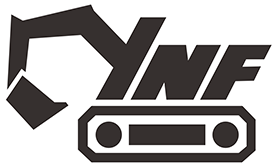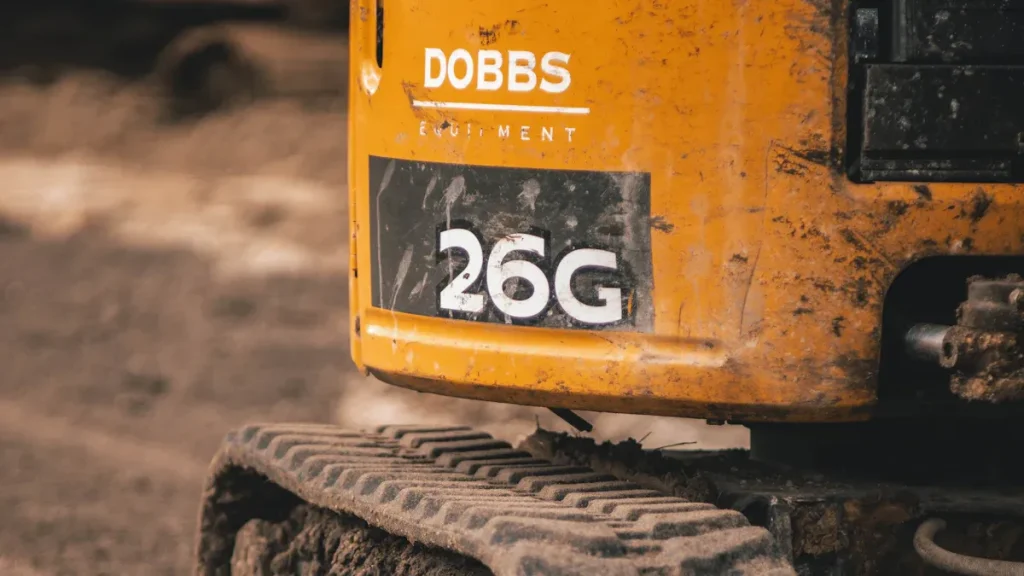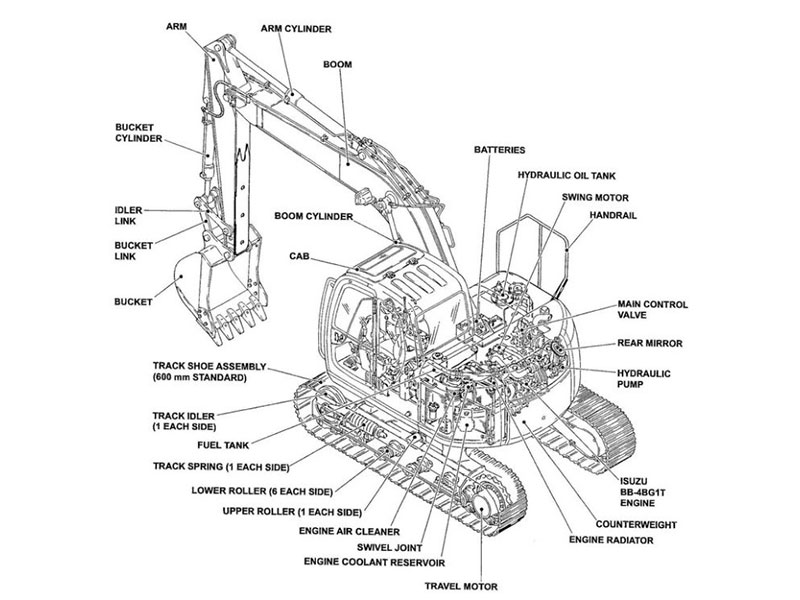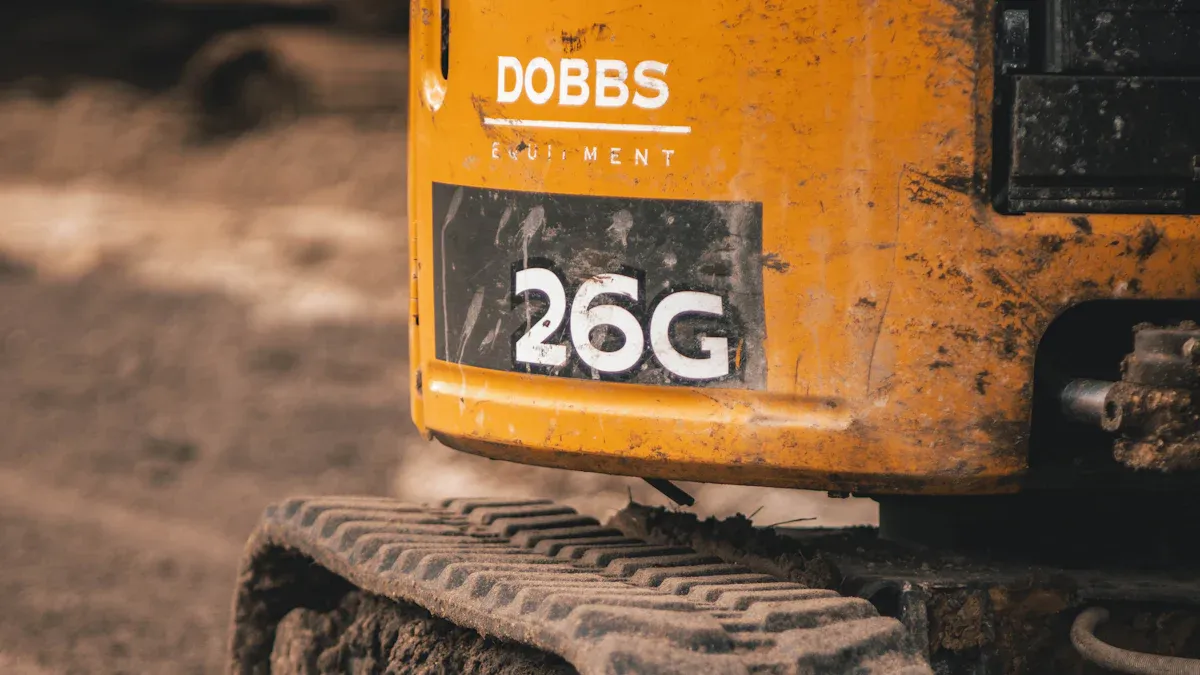
Excavator wear parts are bucket teeth, cutting edges, side wear plates, and shrouds. These important parts help you dig, cut, and protect the excavator bucket. You should look for damage or if they stop working well. Good quality is important, so always pick high-quality replacement parts for excavators. Using good replacement parts keeps your excavator working well and helps you do a good job. Changing worn parts quickly makes work better and saves time. Trustworthy replacement parts keep your machine safe.
Changing and taking care of excavator wear parts often helps you work better, makes your equipment last longer, and gives you good results.
Key Takeaways
Check excavator wear parts often. Look at bucket teeth, cutting edges, and hydraulic hoses. This helps you find damage early. It keeps your machine working well.
Change worn parts right away. This stops bigger problems. It saves time and lowers repair costs.
Use good replacement parts. This makes your machine strong and safe. It also helps your machine last longer.
Follow a maintenance schedule. Clean your machine and add oil when needed. Change filters to keep your excavator working well.
Taking care of your excavator is important. It helps you work faster and save money. You also get better results on every job.
Essential Wear Parts
Bucket Teeth
Bucket teeth are very important for excavators. They help break up dirt, rocks, and trash. These teeth make digging faster and easier. They also help your machine work well. Bucket teeth get worn out from hitting and rubbing things. When teeth get dull or broken, digging gets harder. You also use more fuel to finish the job. Hard-faced teeth last longer and do not get damaged as fast. This makes them stronger and more dependable. If you change old teeth quickly, you protect other parts. You also keep your work good.
Teeth Type / Treatment Method | Loading Cycles Until First Pitting (×10⁶) | Pitted Surface Area at 98 × 10⁶ Cycles (%) |
|---|---|---|
Newly Manufactured Teeth | 69 | 18 |
Hard-faced with EVB2CrMo | 70 | 50 |
TIG Hard-faced with DUR 600-IG | 74 | 12 |
Cutting Edges
Cutting edges are found at the bottom of the bucket. They help cut through hard stuff and protect the bucket. These parts get scratched a lot, especially in rocky or sandy places. If cutting edges wear out, digging gets harder. You have to work more to finish the job. Checking and changing them often keeps your machine working well. Good cutting edges last longer and help you dig better. How you use the machine and what you dig also matter.
Blasting material well helps parts last longer.
Dragging tools or using them wrong wears them out faster.
Checking parts often stops big repair bills.
Side Wear Plates
Side wear plates protect the bucket’s sides from hits and scrapes. They take most of the damage from rocks and trash. If you see cracks or thin spots, you should get new ones. New ways to make these plates make them stronger and better. Good side wear plates stop rust and last longer. This makes your machine more reliable and cheaper to fix.
Wear Plates and Shrouds
Wear plates and shrouds cover the parts that get hit the most. They act like shields and keep the bucket safe. You should look at these parts a lot, especially if you work in rough places. Changing them fast keeps your machine safe and working well. Good materials and the right fit make them last longer and work better. This saves you money over time.
If you take care of excavator wear parts, like bucket teeth and hydraulic seals, you can cut down on repairs by 30% and save 20% on costs. Good parts keep your machine strong and working well, even in hard jobs.
Undercarriage Excavator Parts

Tracks and Track Pads
Tracks and track pads help your excavator move on many surfaces. They give the machine grip and keep it steady. If you see cracks or missing pieces, you need new ones. Worn tracks make your work slow and less safe. Good tracks help you finish jobs faster and keep the machine balanced. Using strong replacement parts makes them last longer. This also saves you money because you avoid big repairs.
Rollers and Idlers
Rollers and idlers help guide and hold the tracks in place. They spread the weight of the excavator as it moves. If rollers or idlers wear out, you may hear odd sounds or see tracks slip. Look for dents, flat spots, or leaks on these parts. Changing them quickly keeps your excavator working well. This helps you work faster and stops long breaks.
Sprockets and Chains
Sprockets and chains help move the tracks by giving them power. They take energy from the engine and send it to the tracks. If you see worn teeth or stretched chains, you need new ones. Bad sprockets can make tracks jump or slip off. Check these parts often to keep your excavator strong and safe. Good replacement parts make them last longer and ready for hard work.
Rubber Pads
Rubber pads protect roads and lower noise when you use your excavator. They also help spread the machine’s weight on the ground. New rubber pads use both natural and fake rubber to stop tearing. The way rubber sticks to steel cores keeps them from coming apart. Forged steel cores make pads stronger than cast steel ones. New ideas like heat-proof rubber and anti-slip treads help pads last longer. Some pads even have sensors to tell you when to change them. Picking the right rubber pads gives you better safety and helps your machine work well.
Tip: Check your undercarriage parts often. Changing them early keeps your excavator safe and working well.
Hydraulic Wear Parts for Excavators
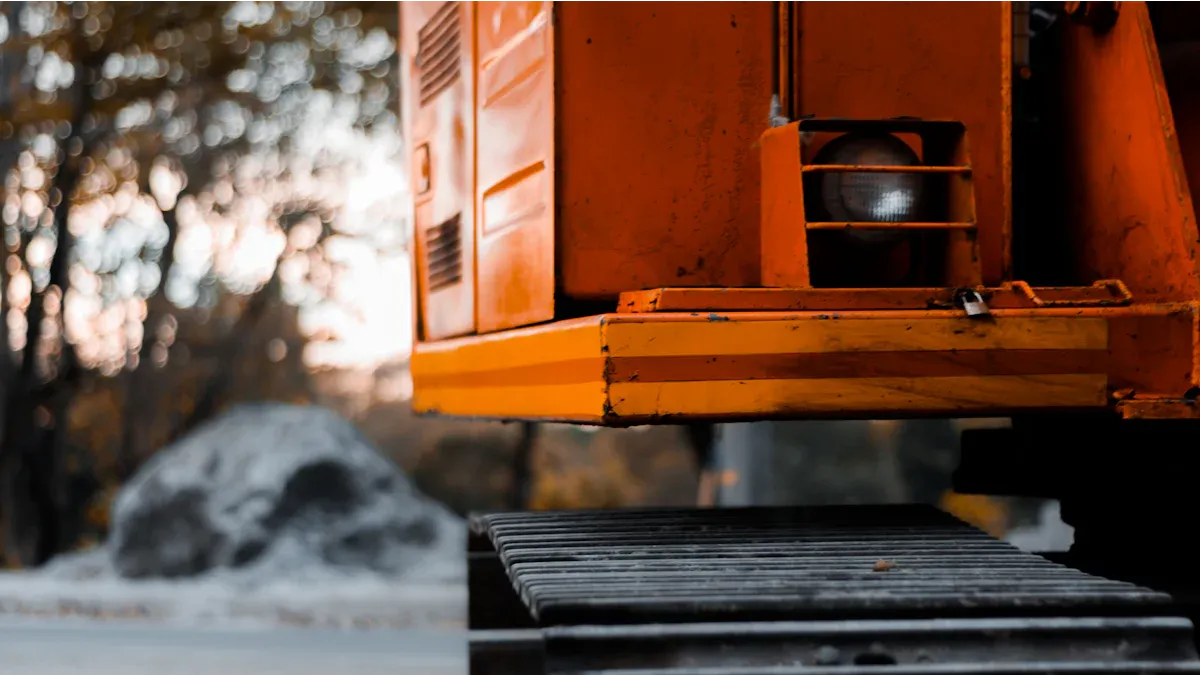
Hydraulic Hoses
Hydraulic hoses carry fluid in the excavator’s hydraulic system. These hoses face high pressure and heat every day. You should look for cracks, leaks, or bulges on hoses. If you see any damage, change the hose right away. Good hoses help stop breakdowns and keep your machine safe. If a hose fails, your machine may stop working for a long time. Repairs can cost a lot of money. Some hoses, like Parker’s GlobalCore, are made to last longer and meet strict rules. Using asset tags and the right tools helps you change hoses faster and with fewer mistakes. Strong hoses help your excavator work well and keep the hydraulic system running.
Seals and Gaskets
Seals and gaskets keep fluid inside the hydraulic system. They also stop dirt from getting in. Seals can wear out, flatten, or crack over time. Gaskets can lose their shape or let fluid leak out. When this happens, you may see oil leaks or less pressure. Studies show that worn seals lose their shape and do not seal well. Leak rates go up as seals get worse. You can use tests and models to guess when seals will fail. Changing seals and gaskets on time keeps your hydraulic system strong.
Study Focus | Method/Model Used | Key Finding |
|---|---|---|
Seal wear and leakage | Leak rate models and experiments | Leak rates rise as seals wear |
Seal stress and deformation | Compression and stress analysis | Worn seals lose shape and sealing ability |
Cylinders and Pins
Cylinders and pins help move the arms and bucket. They use hydraulic power to lift and dig. If these parts wear out, the machine may move slowly or dig weakly. Hard minerals and dust can make cylinders wear out faster. If you see jerky moves or hear odd sounds, check the cylinders and pins. Harder surfaces and better ways to put pins together help them last longer. Checking these parts often helps you find problems early and keep your excavator working.
High abrasive materials make cylinders wear out faster.
Harder surfaces help stop failures.
Good assembly lowers stress and wear on pins.
Swing Bearings
Swing bearings help the excavator turn smoothly. They hold heavy loads and move all the time. If swing bearings wear out, turning may feel rough or sound bad. Look for loose bolts, leaks, or metal shavings. Keeping the hydraulic system clean and oiled helps swing bearings last longer. You should follow a regular schedule to keep swing bearings from failing.
Tip: Check fluid levels every day, change filters often, and watch for leaks. These steps help you find worn hydraulic parts before they break. This protects your excavator and saves money on repairs.
Engine and Filter Excavator Parts
Engine Belts and Gaskets
Engine belts and gaskets help your excavator work well. Belts move things like the alternator and water pump. If a belt breaks or slips, the engine can get too hot or lose power. Gaskets keep engine parts sealed tight. If a gasket fails, oil may leak or the engine may not work right. Check belts and gaskets often to find problems early. Changing them on time keeps the engine safe and working well.
Air, Oil, and Fuel Filters
Filters keep dirt out of your engine. Air filters stop dust from getting inside. Oil filters clean the oil so parts move smoothly. Fuel filters block dirt and water from the fuel. Clean or change air filters every 100 hours, especially in dusty places. Change oil and oil filters every 200 to 300 hours. Replace fuel filters every 300 hours to keep the engine strong. Keeping up with filter changes can stop sudden breakdowns by 30%. Use a checklist to remember when to change filters and keep your machine running well.
Tip: Change filters on a schedule. This saves money and stops big repairs.
Typical Maintenance Intervals:
Daily: Check coolant, engine oil, and hydraulic oil.
Monthly: Change engine oil and filter.
Every three months: Clean the fuel tank cap and strainer.
Every six months: Replace hydraulic oil filters.
Cooling System Components
Cooling system parts stop your excavator from getting too hot. Radiators, fans, thermostats, and pumps all help cool the engine. Each part lasts a certain number of hours. Radiators last 5,000 to 10,000 hours. Fans may need changing after 2,000 to 5,000 hours. If the engine gets too hot, leaks, or makes odd sounds, check these parts soon.
Component | Typical Lifespan (hours) | Signs of Wear |
|---|---|---|
Radiators | 5,000–10,000 | Overheating, leaks, clogged fins |
Fans | 2,000–5,000 | Noises, reduced airflow, overheating |
Thermostats | 5,000–7,000 | Irregular temps, leaks, overheating |
Pumps | About 5,000 | Noisy, leaks, poor coolant flow |
Dust, dirt, and bad coolant can wear out cooling parts faster. Clean and check these parts often. Use good coolant and follow service times to keep your excavator cool and working hard.
Maintenance and Signs of Wear
Identifying Wear
You can find wear on your excavator by checking it every day. Look for cracks, dents, leaks, or missing parts. Bucket teeth may look dull or have chips. Cutting edges can look thin or not even. Tracks and pads might have cracks or missing pieces. Hydraulic hoses may bulge or leak. If you see oil under the machine, seals or gaskets may be bad. Listen for strange sounds when the excavator moves or turns. These noises can mean rollers, idlers, or swing bearings need help.
A new way uses data from maintenance records to spot wear faster. In one mining job, experts checked over 600 records from 26 excavators. They used computers to sort out different wear problems. This helps you see how parts wear out over time. You can use this to plan when to fix things before they break. By using your eyes and smart data, you keep your excavator working well.
Tip: Check your excavator every day. This helps you find problems early and keeps your machine safe.
When to Replace
You should change worn parts fast to keep your excavator working well. If you see these signs, plan to replace parts soon:
Bucket teeth are dull, cracked, or missing.
Cutting edges are thin or bent.
Tracks or pads have deep cracks or missing pieces.
Rollers or idlers make grinding sounds or leak.
Seals and gaskets let oil leak out.
Engine belts slip or look worn.
Filters are dirty or blocked.
Changing worn parts on time keeps your excavator running smooth. Always use good replacement parts for every fix. This makes your machine work better and last longer. Good parts also help you save time and work faster. If you wait too long, small problems can get worse. You may lose time and money. Changing parts on time is the best way to keep your machine strong.
Note: Always follow the maker’s guide for when to change parts. This keeps your excavator safe and working well.
Maintenance Tips
You can help your excavator last longer by following easy tips. These steps help you keep quality, efficiency, and strength:
Check your machine every day to find wear early.
Clean all parts to get rid of dirt and junk.
Oil moving parts like pins and bushings to stop rubbing.
Use the right ways to run your machine. Don’t be rough or use too much force.
Follow a plan to check and fix all parts.
Pick good replacement parts from trusted sellers. This helps your machine work better.
Change worn parts fast to stop surprise breakdowns.
Ask an expert for help with hard fixes.
Experts say regular care and quick fixes make your excavator work better. They say, “Changing worn parts on time stops breakdowns and helps your machine last longer.” Cleaning and oiling parts also help your machine work well. Using good parts makes sure your excavator is always strong and reliable.
Maintenance Task | How Often | Why It Matters |
|---|---|---|
Daily inspections | Every day | Find wear early, keep machine strong |
Cleaning | After each use | Keep parts working well |
Lubrication | Weekly | Stop rubbing, help parts last longer |
Replacement of filters | As scheduled | Keep engine and hydraulics clean |
Replacement of worn parts | As needed | Stop breakdowns, keep quality high |
Remember: Regular care and quick fixes help your excavator work its best. Good replacement parts give you better quality, strength, and efficiency for every job.
If you check your excavator often, it stays strong. Fixing parts quickly stops big problems. This helps you avoid losing time and money. Many companies save money by checking machines on a schedule. New tools and technology also help them work better.
One mining company saved money with a good maintenance plan.
Studies show regular care can make machines work 40% better.
Try these tips now to keep your machine safe and get great results on every job.
FAQ
What are the first signs that excavator wear parts need replacing?
You may see cracks, chips, or thinning on bucket teeth and cutting edges. Tracks can show missing pads or deep cracks. Listen for odd noises or feel rough movement. These signs mean you should check and replace parts soon.
How often should you inspect excavator wear parts?
Check your excavator every day before you start work. Daily checks help you find problems early. You can use a simple checklist to make sure you do not miss any important parts.
Can you use aftermarket parts for excavator repairs?
Yes, you can use aftermarket parts. Make sure you pick high-quality parts from trusted sellers. Good aftermarket parts can work as well as original ones and may save you money.
What happens if you ignore worn excavator parts?
Ignoring worn parts can cause breakdowns, unsafe work, and higher repair costs. Your excavator may stop working in the middle of a job. You might also damage other parts, which leads to more expensive fixes.
How do you make excavator wear parts last longer?
Clean your machine after each use.
Lubricate moving parts weekly.
Use your excavator the right way.
Replace worn parts quickly.
Follow the maker’s maintenance schedule.
These steps help you get the most life from your excavator parts.
